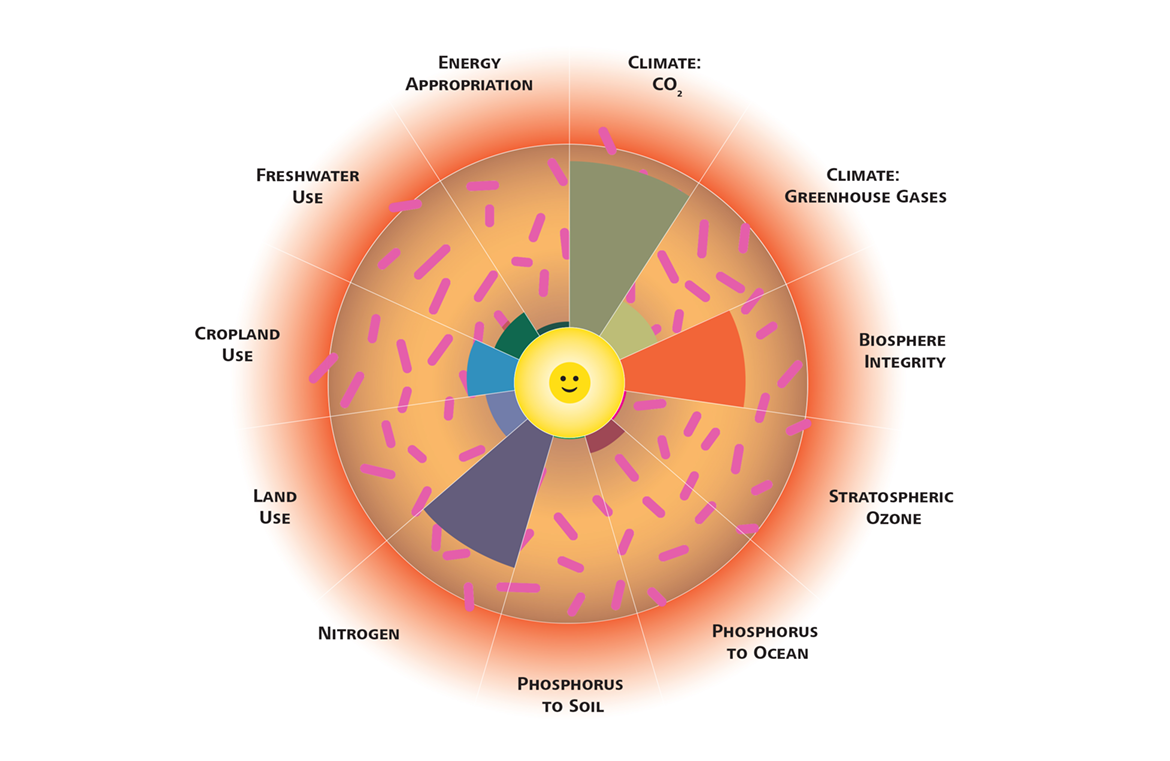Measuring the doughnut
A good and ecological life is possible for all
Sustainability and quality of life – a contradiction? Not necessarily, shows a new study by Empa researchers. According to their calculations, an ecologically and socially just life is possible for over ten billion people. It will, however, require a paradigm shift.

Today, humanity is not treating the Earth sustainably. Global warming, deforestation and a decline in biodiversity are causing problems for our planet. For many, this status quo leads to pessimism: Is it even possible to create an ecological and good life for all people on Earth? Empa researchers say: Yes! In a new study in the Journal of Cleaner Production, they have shown that – at least technically – more than ten billion people can live sustainably on Earth – and that a decent standard of living can still be achieved for everyone.
For their calculations, Hauke Schlesier and Harald Desing from Empa's Technology and Society laboratory, together with Malte Schäfer from the Technical University of Braunschweig, used the so-called doughnut model. This model consists of two concentric circles. The outer circle represents the limits of key planetary resources, including biodiversity, climate, and land and water use, which, if exceeded, increase the risk of large-scale, abrupt and irreversible environmental changes. A filled inner circle means that basic human needs have been met and an adequate standard of living has been achieved for all. The doughnut itself is the area between these two circles: The amount of natural resources that could still be safely used beyond the achievement of an adequate standard of living.

Understanding the needs
Until now, the existence of the doughnut was merely a postulate. No study has yet been able to show whether all people can have their basic needs met without exceeding the planetary boundaries. Where these planetary boundaries lie has already been described in the scientific literature. But how do you quantify people's basic needs? "That was the biggest challenge in this study," says Hauke Schlesier.
After extensive research, the researchers finally put together a hypothetical "shopping basket". This contains a selection of goods and services that are essential for an adequate standard of living. The basket includes food and water, housing, electricity and mobility, but also hospitals for healthcare and schools for education, public areas and meeting places, as well as modern means of communication. "Of course, people have other basic needs, such as the need for security, but these do not necessarily have to consume material resources," explains Schlesier.
The researchers then compared the environmental damage caused by the provision of the shopping basket with the planetary boundaries. Their result: "We were able to show that an adequate and ecological life for more than ten billion people is very likely possible," says Schlesier. "However, this requires a fundamental change in many of the systems we use today to provide these essential goods and services."
Making better use of resources
So what would it take for us to live sustainably? According to the researchers, the most urgent requirement is to rethink the energy system and agriculture. "The planetary boundaries that are most severely exceeded today are the climate system, biodiversity and the biogeochemical fluxes of phosphorus and nitrogen," explains Desing.
Achieving a decent standard of living for all within planetary boundaries requires a complete renunciation of fossil fuels and a shift in agriculture towards a predominantly plant-based diet. This does not mean that meat consumption will no longer be possible in the future, Schlesier clarifies. With some forms of extensive farming, animal husbandry would remain possible – just not to the same extent as it is today, since modern factory farming puts too much strain on the system. "Our model also includes no more land use change, i.e. no further conversion of natural landscapes into farmland," explains Desing. "By eliminating the large pastures and fields for growing animal feed, there would be more than enough arable land to feed humanity."
Another important transformation on the way to the doughnut is the alignment of living standards with basic needs. "In large parts of the global South, this would mean a sharp rise in living standards," says Schlesier. In some countries in the global North, including Switzerland, resource consumption would have to be more modest than it is today. "However, this does not necessarily mean a reduction in well-being," explains the researcher. "Studies have shown that well-being stagnates above a certain level of prosperity and no longer increases further." In rich countries such as Switzerland, a reduction in living space and a lower level of individual mobility can lead to a more appropriate standard of living. On the other hand, public transport and healthcare can certainly be expanded without significantly increasing environmental damage, assures Harald Desing.
Thus, the doughnut of sustainable living does indeed exist – but it is very narrow. "With all these transformations, we would only just achieve the doughnut in our model, but there is hardly any leeway," says Desing. However, this does not mean that humanity can never go beyond this reasonable standard of living. "Our model does not take into account all conceivable future changes. We still have a few aces up our sleeve," says Schlesier. The calculation is based on today's stat of the art in technology. The researchers are convinced that technological progress, different agricultural practices and a shift towards a circular economy could certainly create ecological leeway.
Hauke Schlesier
Technology and Society
Phone +41 58 765 73 43
Dr. Harald Desing
Technology and Society
Phone +41 58 765 75 13
H Schlesier, M Schäfer, H Desing; Measuring the Doughnut: A good life for all is possible within planetary boundaries; Journal of Cleaner Production (2024); doi: 10.1016/j.jclepro.2024.141447






